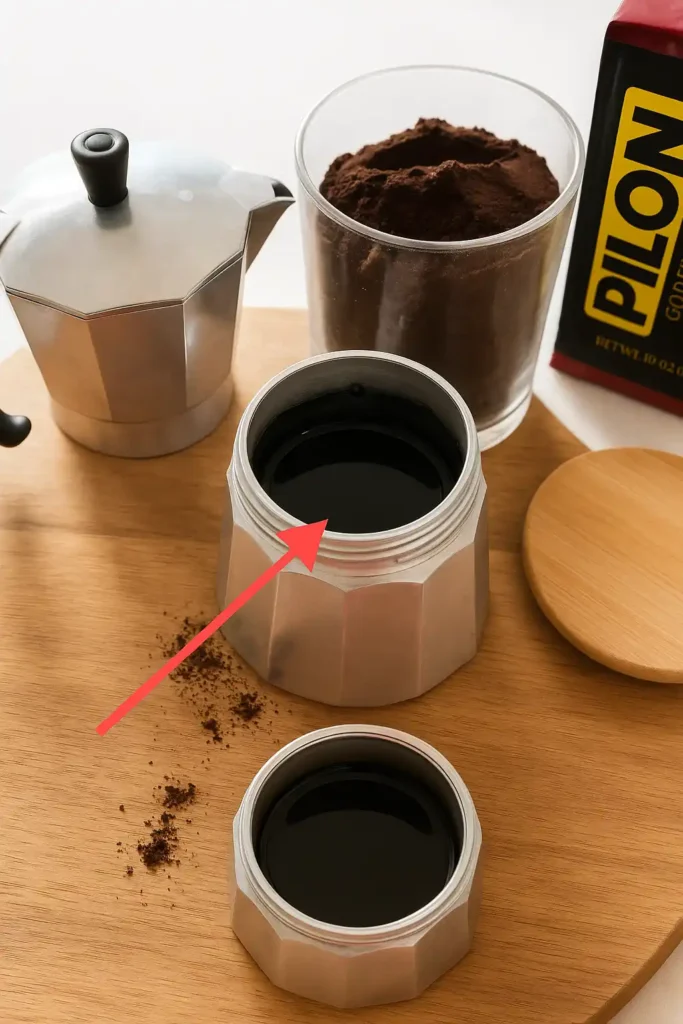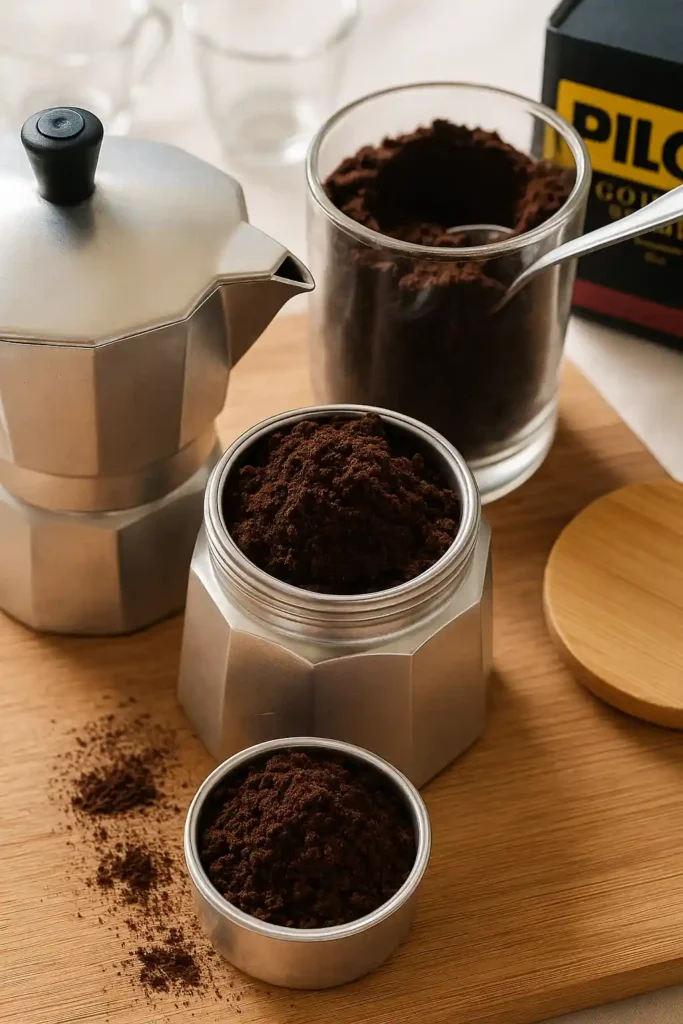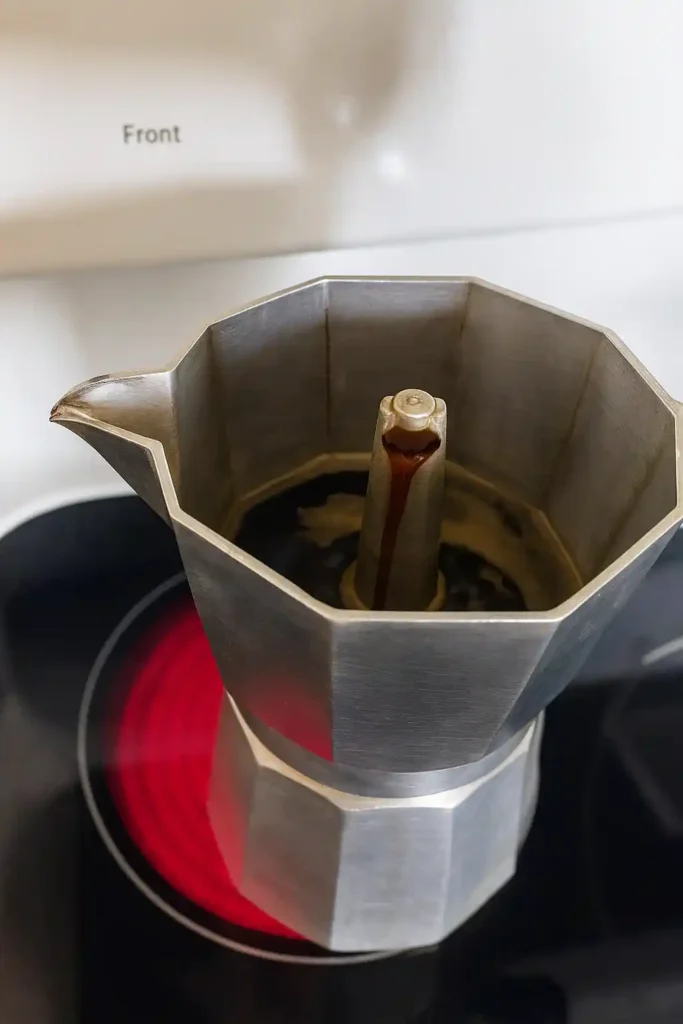Café Cubano Cuban coffee was never just about caffeine for me it was about community. I still remember the first time I tasted it. It wasn’t in a trendy café or on a family vacation to Havana. No, my introduction to Café Cubano Cuban coffee happened right in my modest apartment kitchen, thanks to my neighbor, Doña Rosa.
Doña Rosa was the kind of woman who woke up early, wore lipstick even on Sundays, and whose kitchen always smelled like toasted sugar and dark roast beans. Every afternoon, around 3:00 PM sharp, she would sit by her window and sip what she lovingly called her “afternoon blessing.” One day, she waved me over.
“Elle,” she said, “you’ve never really lived until you’ve had a proper cafecito.”
Curious, I joined her at her table, where she handed me a tiny porcelain cup filled with this rich, fragrant brew Café Cubano Cuban coffee, strong and sweet with a foamy golden crown on top. That moment changed my coffee life forever.
It wasn’t just the flavor that hooked me. It was the ritual. The way she whipped the sugar with just a few drops of espresso to create that creamy espuma. The way she poured the rest of the coffee slowly over it, careful not to disturb the foam. She told me how every Cuban family had their way of making it, but the love and patience were always the same.
I started learning from her day by day. Soon, I had my own moka pot. I practiced creating the perfect espuma, even burned a few pots of coffee in the process. But it was worth it. Making Café Cubano Cuban coffee became my own afternoon ritual a sweet, bold pause in the day that reminded me to slow down and savor the little things.
Today, I pass this tradition on to friends, family, and anyone who visits my kitchen. Because once you’ve tasted a cup made with care, you understand it’s not just a drink. It’s heritage in a cup. And in this guide, I’ll show you exactly how to bring that experience into your own home.
Step-by-Step Café Cubano Recipe – How to Make Authentic Cuban Coffee
PrintCafé Cubano Cuban Coffee – The Strong, Sweet Legacy in a Cup
Learn to make Cafe Cuban like a pro! All you need to make the best Cuban coffee is a Moka Pot and this recipe! Prefer a little milk in your coffee? Try the Cortadito or Cafe Con Leche variations.
- Prep Time: 3 minutes
- Cook Time: 5 minutes
- Total Time: 8 minutes
- Yield: 4 1x
- Category: coffee
- Method: stovetop
- Cuisine: cuban
Ingredients
- 3 tablespoons Cuban espresso coffee, ground
- 3 tablespoons brown sugar ( you can also use white sugar, if you prefer)
- A moka pot (for stovetop espresso)
Instructions
- Moka Pot: The amount of coffee and water will depend on the size of your Moka Pot. Mine holds about 9 ounces of water, enough for about 4 espresso shots of 2 ounces each.
- Water: Fill the bottom chamber of your Moka Pot with enough water to reach the safety valve.
- Coffee: Fill the coffee filter until it’s full. Pat the coffee down and top off with just a little more. Pat it down so it’s about level. Twist on the top chamber.
- Heat: Set the Moka Pot on the stove top on high heat and wait for the water to boil. You will hear it start to boil. For my size pot, boiling starts after 3 minutes. About a minute after that, you should get your first drips of coffee. This is the coffee you want to use for the espumita. Once the coffee starts to spurt out, you can turn off the heat.
- Sugar Pitcher: Once you set the pot on the stovetop. Add sugar to your stirring pitcher or glass measuring cup. Add about the same amount of sugar as you did the coffee. My coffee filter holds about 3 tablespoons of coffee, so I end up using 3 tablespoons of sugar. I like my coffee on the sweet side, though. You’ll have to experiment with it and see what coffee/sugar ratio you like best.
- Espumita (foam): Take a scant teaspoon of the first brewed coffee and add it to the sugar in the pitcher. Stir until you get a rich, creamy paste. It should be lightened in color as you stir. Once the coffee is down brewing, pour it into the pitcher with the sugar paste and stir.
- Espresso Shot: Pour into your demitasse cup and enjoy!
- Cortadito: Steam about one ounce of milk and pour into the demitasse cup. Fill with about one ounce of espresso. I like my cortadito light, but others like it stronger and darker. You can alter the ratio to your liking.
- Café Con Leche: Steam about six ounces of milk and add to a regular size cup. Add as much espresso as you like. Taste and adjust sugar, if needed.
- Evaporated Milk: You can use regular milk or evaporated milk, which is what my mom used to make. If you’re using evaporated milk, you can mix it with water in a one-to-one ratio.
Notes
- Make sure that all the elements (Moka Pot, pitcher, spoon) are dry before you start brewing. Otherwise, the foam will not be as rich. It will be literally watered down.
Nutrition
- Serving Size: 2 ounces
- Calories: 27
- Sugar: 6.5g
- Sodium: 4mg
- Carbohydrates: 6.9g
- Protein: 0g
- Cholesterol: 0mg
Ingredients and tools needed for the perfect Cuban coffee recipe
To make authentic Café Cubano Cuban coffee, you’ll need:
- A moka pot (for stovetop espresso)
- Finely ground dark roast Cuban coffee (like cubano roast coffee)
- White sugar
- Demitasse cups for serving
This simple setup creates a drink rooted in generations of tradition. No fancy gadgets needed just quality beans and a little patience.
Steps to make a Cubano coffee with espuma at home




- Moka Pot: The amount of coffee and water will depend on the size of your Moka Pot. Mine holds about 9 ounces of water, enough for about 4 espresso shots of 2 ounces each.
- Water: Fill the bottom chamber of your Moka Pot with enough water to reach the safety valve.
- Coffee: Fill the coffee filter until it’s full. Pat the coffee down and top off with just a little more. Pat it down so it’s about level. Twist on the top chamber.
- Heat: Set the Moka Pot on the stove top on high heat and wait for the water to boil. You will hear it start to boil. For my size pot, boiling starts after 3 minutes. About a minute after that, you should get your first drips of coffee. This is the coffee you want to use for the espumita. Once the coffee starts to spurt out, you can turn off the heat.
- Sugar Pitcher: Once you set the pot on the stovetop. Add sugar to your stirring pitcher or glass measuring cup. Add about the same amount of sugar as you did the coffee. My coffee filter holds about 3 tablespoons of coffee, so I end up using 3 tablespoons of sugar. I like my coffee on the sweet side, though. You’ll have to experiment with it and see what coffee/sugar ratio you like best.
- Espumita (foam): Take a scant teaspoon of the first brewed coffee and add it to the sugar in the pitcher. Stir until you get a rich, creamy paste. It should be lightened in color as you stir. Once the coffee is down brewing, pour it into the pitcher with the sugar paste and stir.
- Espresso Shot: Pour into your demitasse cup and enjoy!
- Cortadito: Steam about one ounce of milk and pour into the demitasse cup. Fill with about one ounce of espresso. I like my cortadito light, but others like it stronger and darker. You can alter the ratio to your liking.
- Café Con Leche: Steam about six ounces of milk and add to a regular size cup. Add as much espresso as you like. Taste and adjust sugar, if needed.
- Evaporated Milk: You can use regular milk or evaporated milk, which is what my mom used to make. If you’re using evaporated milk, you can mix it with water in a one-to-one ratio.
The Rich History and Cultural Roots of Café Cubano
The origins of Cuban coffee culture
Café Cubano Cuban coffee has been at the heart of Cuban culture since the 18th century. Coffee arrived in Cuba through Spanish colonists, but it didn’t take long for it to evolve into something entirely unique. Grown in the eastern mountains and roasted dark, coffee quickly became more than just a crop it became tradition.
By the 1900s, coffee wasn’t just a beverage; it was a symbol of daily life. Morning routines, neighborly chats, and even political debates were built around cups of Café Cubano Cuban coffee. It was always about more than the drink it was about connection, hospitality, and the Cuban spirit of resilience.
Why Café Cubano is more than just a drink in Cuban homes
In Cuban households, Café Cubano Cuban coffee is sacred. It marks the start of a new day, the bridge between meals, and a way to welcome guests. Children grow up watching their elders prepare it in moka pots, listening to the bubbling sounds, and waiting eagerly for their first taste.
The thick sugar foam, or espuma, is passed down as a culinary ritual. It’s a recipe often taught not by books, but by heart. Making Café Cubano Cuban coffee is often the first rite of passage into adulthood, showing one’s place in the family and culture.
What Sets Café Cubano Apart from Regular Coffee
Why is Café Cubano so strong and sweet?
Café Cubano Cuban coffee is famous for its robust flavor and intense sweetness. But why? The answer lies in how it’s made. Unlike regular espresso, this Cuban delight starts with dark roast beans and ends with whipped sugar foam.
The brewing method extracts bold flavors, and the sugar whipped with the first drops of espresso creates a creamy layer on top. This process makes Café Cubano Cuban coffee both powerful and smooth, balancing the sharp bitterness of the roast with irresistible sweetness.
How Cuban coffee brewing compares to espresso or drip coffee
Unlike espresso that uses high-pressure machines or drip coffee that filters slowly, Café Cubano Cuban coffee is made in a stovetop moka pot. The pressure is lower, but the results are strong and syrupy. Espresso machines deliver crema; Cubano coffee delivers espuma.
While drip coffee can taste watered down and espresso too bitter for some, Café Cubano Cuban coffee finds a delicious middle ground. It’s concentrated but not harsh, sweet but not cloying a perfect representation of Cuban culinary balance.
Exploring the Main Types of Cuban Coffee Drinks
Café Cubano vs Cuban Colada vs Cortadito vs Café con Leche
There are four key types of Café Cubano Cuban coffee drinks. The basic Cafecito is a single shot with rich espuma. Then there’s the Colada, a larger portion served in a foam cup and shared in tiny demitasse cups.
The Cortadito mixes Cuban coffee with a small splash of milk, usually in a 1:1 ratio. Lastly, Café con Leche combines a shot of Café Cubano Cuban coffee with a generous amount of steamed milk, often enjoyed at breakfast. Each has its own taste profile but all start with the same beloved base.
What is the difference between cafecito and colada?
The difference lies in purpose. A cafecito is personal a quick shot of bold sweetness. A colada, however, is social. Brewed the same way, it’s poured into several small cups and shared with friends or coworkers. In Cuban-American communities, offering a colada is a sign of camaraderie.
Despite their size differences, both keep the heart of Café Cubano Cuban coffee alive through ritual and tradition.
Cuban Coffee Variations and Modern Twists
Cold brew Cubano coffee and iced café versions
Modern coffee lovers are reinventing Café Cubano Cuban coffee with iced and cold brew versions. Simply chill the brewed coffee and pour over ice, or cold brew it overnight using Cuban-style grounds. The result? A refreshing drink with the same deep flavor and sweet finish.
This twist is perfect for warm climates or those looking to enjoy the boldness of Cuban coffee in a cooler way.
Popular flavored Cuban coffee like vanilla, hazelnut, or condensed milk
Want to add a twist to your Café Cubano Cuban coffee? Try flavored syrups like vanilla, hazelnut, or caramel. Some cafés even use sweetened condensed milk for a richer, dessert-like experience.
These modern takes retain the strength of traditional Cuban coffee but appeal to adventurous palates looking for something new.
Cuban Coffee Etiquette and How to Order Like a Local
How to ask for Cuban coffee in a café – essential phrases
If you’re in Miami or a Cuban café, knowing what to say matters. For a single shot, ask for a cafecito. Want to share? Say una colada, por favor. Prefer it with milk? Try un cortadito or café con leche.
Ordering Café Cubano Cuban coffee like a local is part of the experience it shows respect for the culture and guarantees the right brew.
What Cuban coffee is called in Miami and beyond
In Miami, Cuban coffee is affectionately called cafecito. In Tampa, it might still be known as Café Cubano Cuban coffee. Regardless of location, the names reflect pride and familiarity. Using the right term gives your order authenticity and earns smiles from behind the counter.
Why Is Cuban Coffee So Strong? Breaking Down the Strength
Caffeine levels: Is Cuban coffee stronger than American coffee?
Yes, Café Cubano Cuban coffee is stronger in flavor and caffeine. Though brewed without the high pressure of espresso machines, the moka pot still delivers intense, concentrated coffee. A typical shot holds about 50–100 mg of caffeine.
The result? A coffee that feels stronger than a standard cup and keeps you going for hours.
Why Cuban coffee is often served in small cups
Because it’s so bold, Café Cubano Cuban coffee is served in tiny demitasse cups. These small servings deliver a punch and encourage slow sipping. It’s not about quantity it’s about savoring a rich, cultural experience in each drop.
The smaller size also reflects the idea that good things come in small, sweet packages.
Serving Traditions, Pairings & When Cubans Drink Coffee
Why Cubans drink coffee even at night
Unlike most coffee cultures, Cubans drink Café Cubano Cuban coffee throughout the day even after dinner. Thanks to the added sugar, the experience feels comforting rather than jarring. For many, it’s a way to end the day on a warm note, often paired with conversation or dessert.
It’s less about the caffeine and more about the moment.
Traditional food pairings and best times of day
In the morning, Café Cubano Cuban coffee is paired with buttered Cuban toast. In the afternoon, it goes well with pastelitos or sweet pastries. And after dinner, it often accompanies family chats.
There’s never a bad time to enjoy it. It adapts to every part of the day and every kind of craving.
The Best Cuban Coffee Brands and Beans for Café Cubano
Which Cuban coffee brand is best? Our expert picks
Some of the top picks for Café Cubano Cuban coffee include Café Bustelo, Pilon, and La Llave. These brands offer bold, dark roasts perfect for stovetop brewing. They’re widely available and beloved by Cuban-American households.
Whether you’re new or a seasoned sipper, these brands deliver authentic flavor every time.
What is cubano roast coffee? Choosing the right blend for home use
Cubano roast coffee is a dark, finely ground roast tailored for moka pots. It’s bold, rich, and perfect for making traditional Café Cubano Cuban coffee. Look for blends labeled “espresso grind” or “Cuban style.” Avoid light or medium roasts they won’t give you the depth or intensity needed for a proper cafecito.
FAQ – Frequently Asked Questions About Café Cubano Cuban Coffee
What is Café Cubano made of?
Café Cubano Cuban coffee is made from finely ground dark roast coffee beans brewed in a moka pot. It’s sweetened by vigorously mixing the first drops of coffee with sugar to form a creamy foam called espuma.
Why is cafecito so strong?
Cafecito or Café Cubano is strong because it uses dark roast beans and is brewed in a concentrated form. The first few drops are thick and potent, enhanced by the sugar foam that intensifies both sweetness and strength.
What is different about Cubano coffee?
Unlike other coffees, Café Cubano Cuban coffee includes whipped sugar as part of the brewing process. This creates a smooth, sweet crema called espuma. It’s both cultural and culinary a unique blend of bold and sweet.
What is the difference between cafecito and colada?
A cafecito is a single shot of sweet Cuban coffee, while a colada is a larger portion meant for sharing. Both are made the same way, but the colada is served with small cups for communal sipping.
What does Café Cubano taste like?
Café Cubano Cuban coffee is bold, rich, slightly smoky, and intensely sweet due to the espuma. It finishes smooth, never bittermaking it as enjoyable as it is energizing.
What is the strongest coffee?
Café Cubano ranks among the strongest due to its intensity and concentration. While some brews may have higher caffeine, the blend of roast and brewing method makes Café Cubano Cuban coffee taste stronger than most.
What is Cuban coffee with milk called?
It’s called Café con Leche if there’s a lot of milk, and Cortadito if there’s just a splash. Both versions are sweet, creamy, and rooted in the Café Cubano Cuban coffee tradition.
Why is Cuban coffee served in small cups?
Because it’s very strong and sweet. Small demitasse cups offer the perfect portion size for this bold brew. A little goes a long way.
Do Cubans drink coffee at night?
Yes, it’s common. The tradition of drinking Café Cubano Cuban coffee after dinner is widespread. It’s as much about family and flavor as it is about staying awake.
How do you ask for Cuban coffee?
Use terms like cafecito for a single shot, colada for sharing, or cortadito for coffee with milk. In Miami, people commonly say, “Dame un cafecito, por favor.”
Is Cuban coffee stronger than American coffee?
Yes, especially in flavor. Café Cubano Cuban coffee is brewed in a concentrated form with sugar and has a thicker body than standard American coffee.
What is the slang for Cuban coffee?
People often say cafecito or just Cuban. In Miami, asking for a cafecito at a ventanita is as common as asking for water.
Which Cuban coffee brand is best?
Café Bustelo, Pilon, and La Llave are highly recommended for brewing authentic Café Cubano Cuban coffee at home.
What’s the difference between a Cuban and a Cubano?
In coffee terms, Cuban refers to the drink (Cuban coffee), while Cubano can also mean a sandwich. But when it comes to Café Cubano Cuban coffee, both terms are used interchangeably in the U.S.
Why is my Cuban coffee bitter?
It may be due to over-extraction or using the wrong roast. Always use a cubano roast coffee and brew in a moka pot for the best balance of strong and sweet.
Conclusion
Café Cubano Cuban coffee is more than just a caffeinated drink it’s an expression of identity, culture, and love. From the bold aroma to the thick sugar foam, each cup tells a story. Whether shared as a colada with coworkers or sipped alone at dawn, this coffee tradition is alive in every Cuban-American home and ventanita.
Want to discover more about Latin-inspired brews?
Learn more about cubano coffee
Don’t miss our Breve Coffee Recipe


